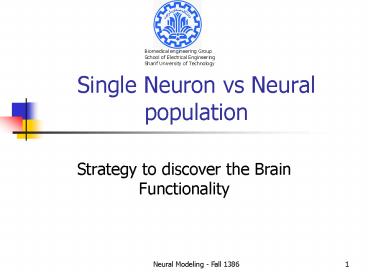Single Neuron vs Neural population - PowerPoint PPT Presentation
Title:
Single Neuron vs Neural population
Description:
The sodium-potassium pump creates a concentration and electrical gradient for Na ... Conversely, the electric field causes both ions tend to come in. Neural ... – PowerPoint PPT presentation
Number of Views:56
Avg rating:3.0/5.0
Title: Single Neuron vs Neural population
1
Single Neuron vs Neural population
Biomedical engineering Group School of Electrical
Engineering Sharif University of Technology
- Strategy to discover the Brain Functionality
2
The Single Neuron
What kind of physical devices are neurons?
Neurons are electro-chemical devices.
Well-characterized in terms of their electrical
properties.
3
Synapse
4
(No Transcript)
5
STRUCTURE
- They have three distinct parts
- (1) Cell body,
- (2) Dendrites, and
- (3) the Axon
- The particular type of neuron that stimulates
muscle tissue is called a motor neuron. - Dendrites receive impulses and conduct them
toward the cell body.
6
Myelinated Axons
- The axon is a single long, thin extension that
sends impulses to another neuron. - They vary in length and are surrounded by a
many-layered lipid and protein covering called
the myelin sheath, produced by the schwann cells.
7
Resting Potential
- In a resting neuron (one that is not conducting
an impulse), there is a difference in
electrical charges on the outside and inside of
the plasma membrane. The outside has a positive
charge and the inside has a negative charge.
8
Contribution of Active Transport
- There are different numbers of potassium ions
(K) and sodium ions (Na) on either side of the
membrane. Even when a nerve cell is not
conducting an impulse, for each ATP molecule
thats hydrolysed, it is actively transporting 3
molecules Na out of - the cell and 2 molecules
- of K into the cell, at
- the same time by
- means of the
- sodium-potassium pump.
9
Contribution of facilitated diffusion
- The sodium-potassium pump creates a concentration
and electrical gradient for Na and K, which
means that K tends to diffuse (leak) out of
the cell and Na tends
to diffuse in. BUT, the membrane is much more
permeable to K, so K diffuses out along its
concentration gradient faster. Conversely, the
electric field causes both ions tend to come in.
10
RESULTS IN
- a net positive charge outside a net negative
charge inside. Such a membrane is POLARISED
11
Action Potential
- When the cell membranes are stimulated, there is
a change in the permeability of the membrane to
sodium ions (Na). - The membrane becomes more permeable to Na and
K, therefore
sodium ions diffuse into the cell down a
concentration gradient. The entry of Na disturbs
the resting potential and causes the inside of
the cell to become more positive relative to the
outside.
12
All-or-None Principle
- Throughout depolarisation, the Na continues to
rush inside until the action potential reaches
its peak and the sodium gates close. - If the depolarisation is not great enough to
reach threshold, then an action potential and
hence an impulse are not produced. - This is called the All-or-None Principle.
Neuron is a physical device that converts an
input voltage change on their dendrites into an
output voltage spike train that travels down
their axon.
13
Speed of Nerve Impulses
- Impulses travel very rapidly
- myelin sheath greatly increases the velocity
- In unmyelinated fibres, the entire axon membrane
is exposed and impulse conduction is slower.
A low-precision electrical device
14
Equivalent Model for Dendrites and Axons
dx
Rdx
Cdx
15
Equivalent Model for an excited Neuron
dx
Rdx
v0(t)
Cdx
The passive membrane time constant in the soma is
on the order of about 10 ms.
16
Transmission of Action Potential/ Dendrite
potential
17
Neuron Transistor
- Electrical devices
- Highly nonlinear
- Signal/information processors
- Short memories Long Memories
- Output voltage spikes proportional
- Heterogeneous Homogeneous
- Biological Manufactured
18
Beyond the single neuron
Ch2,3
Mainly
Population of Neurons
population-temporal representation
ch4
ch5
19
Neural population Benefits
- Varying degrees of detail.
- Extract the information that was nonlinearly
encoded using a linear decoder - Allows many of the tools of linear signals and
systems theory - Ability to better observation
20
NEURAL TRANSFORMATION
- Neural representation paves the way for a useful
understanding of neural transformation - Can be characterized using linear decoding.































